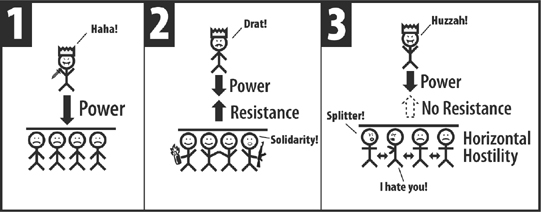The Deep Green Resistance Book
Strategy to Save the Planet



Radical groups have their own particular pitfalls. The first is in dealing with hierarchy, both conceptually and practically. The rejection of authority is another hallmark of adolescence, and this knee-jerk reactivity filters into many political groups. All hierarchy is a tool of The Man, the patriarchy, the Nazis. This approach leads to an insistence on consensus at any cost and often a constant metadiscussion of group power dynamics. It also unleashes “critiques” of anyone who achieves public acclaim or leadership status. These critiques are usually nothing more than jealousy camouflaged by political righteousness. “Bourgeois” is a perennial favorite, as well as whatever flavor of “sell-out” matches the group’s criteria. It’s often accompanied by a hyperanalysis of the victim’s language use or personal lifestyle choices. There is a reason that the phrase “politically correct” was invented on the left.51
There’s a name for this trashing. As noted, Florynce Kennedy called it “horizontal hostility.”52 And if it feels like junior high school by another name, that’s because it is. It can reach a feeding frenzy of ugly gossip and character assassination. In more militant groups, it may take the form of paranoid accusations. In the worst instances of the groups that encourage macho posturing, it ends with men shooting each other. Ultimately, it’s caused by fighting horizontally rather than vertically.

If the only thing we can change is ourselves or if the best tactics for social change are lifestyle choices, then, indeed, examining and critiquing the minutiae of people’s personal lives will be cast as righteous activity. And if you’re not going to fight the people in power, the only people left to fight are each other. Writes Denise Thompson,
Horizontal hostility can involve bullying into submission someone who is no more privileged in the hierarchy of male supremacist social relations than the bully herself. It can involve attempts to destroy the good reputation of someone who has no more access to the upper levels of power than the one who is spreading the scandal. It can involve holding someone responsible for one’s own oppression, even though she too is oppressed. It can involve envious demands that another woman stop using her own abilities, because the success of someone no better placed than you yourself “makes” you feel inadequate and worthless. Or it can involve attempts to silence criticism by attacking the one perceived to be doing the criticising. In general terms, it involves misperceptions of the source of domination, locating it with women who are not behaving oppressively.53
This behavior leaves friendships, activist circles, and movements in shreds. The people subject to attack are often traumatized until they permanently withdraw. The bystanders may find the culture so unpleasant and even abusive that they leave as well. And many of the worst aggressors burn out on their own adrenaline, to drop out of the movement and into mainstream lives. In military conflicts, more soldiers may be killed by “friendly fire” than the enemy, an apt parallel to how radical groups often self-destruct.
To be viable, a serious movement needs a supportive culture. It takes time to witness the same behaviors coalescing into the destructive patterns that repeat across radical movements, to name them, and to learn to stop them. Successful cultures of resistance are able to develop healthy norms of behavior and corresponding processes to handle conflict. But a youth culture by definition doesn’t have that cache of experience, and it never will.